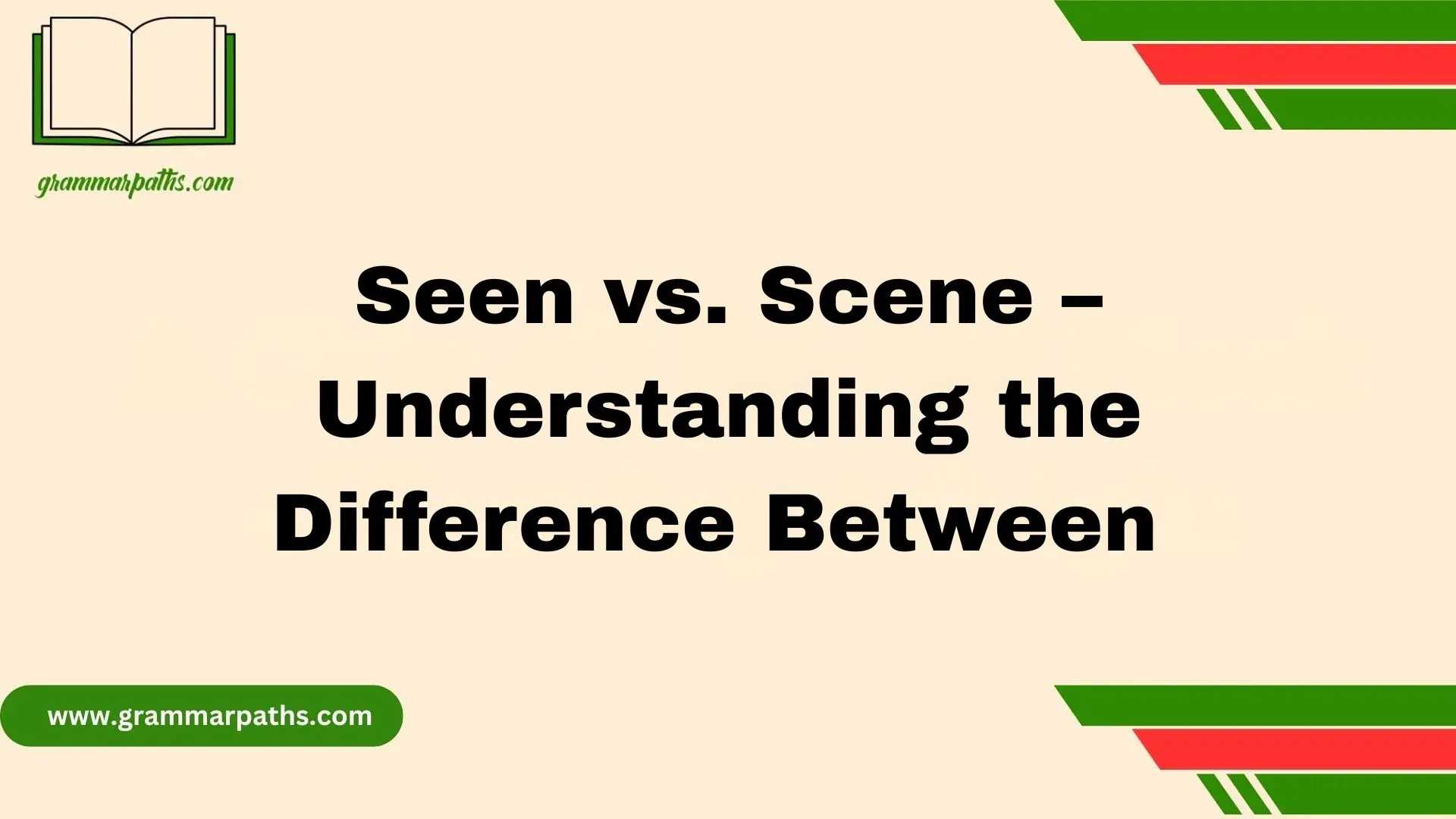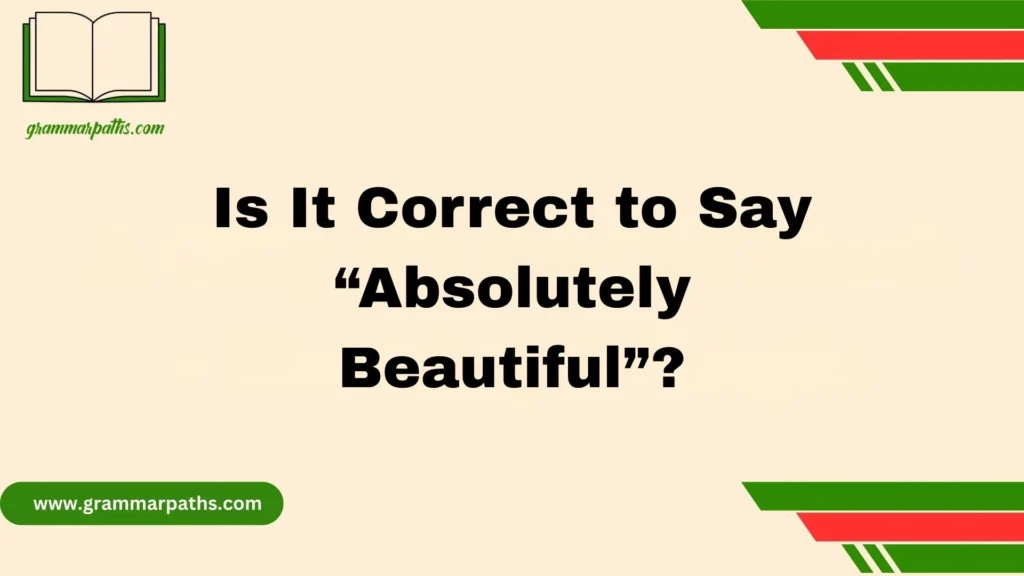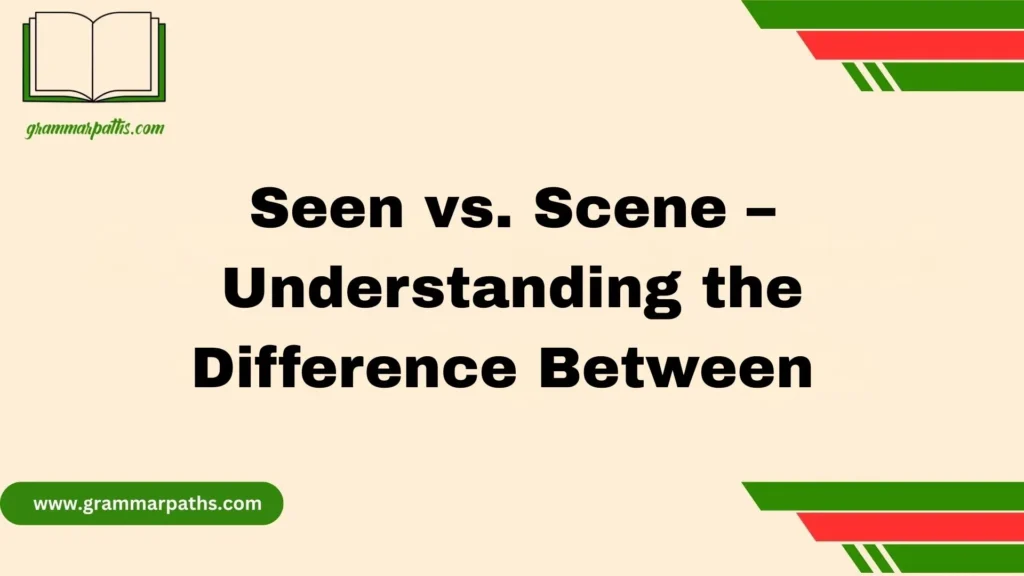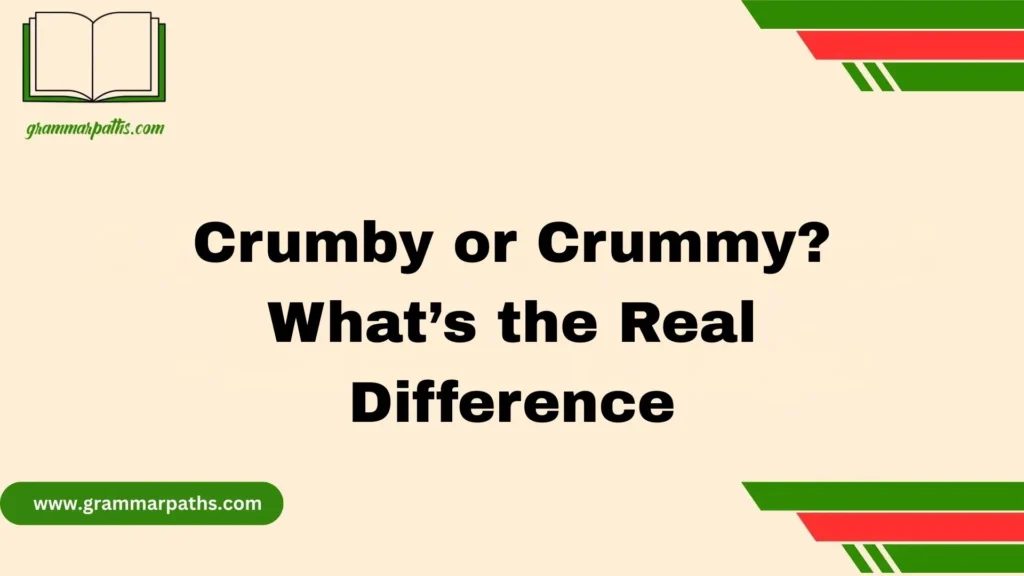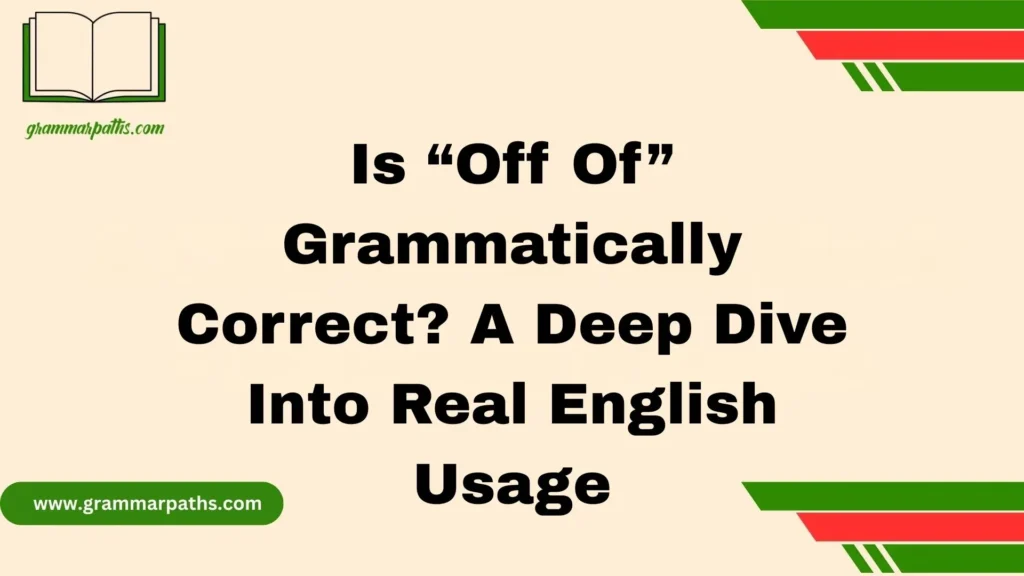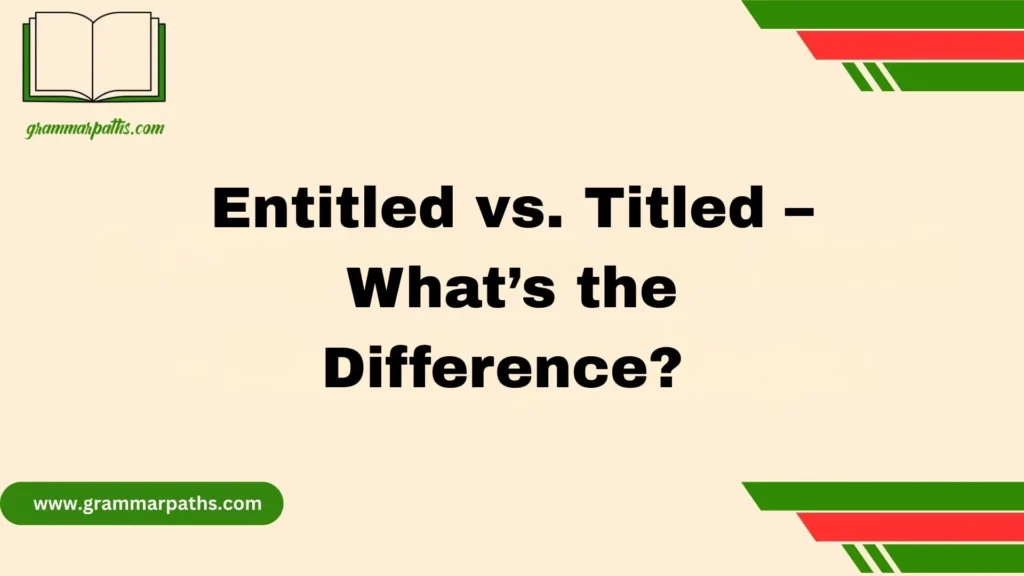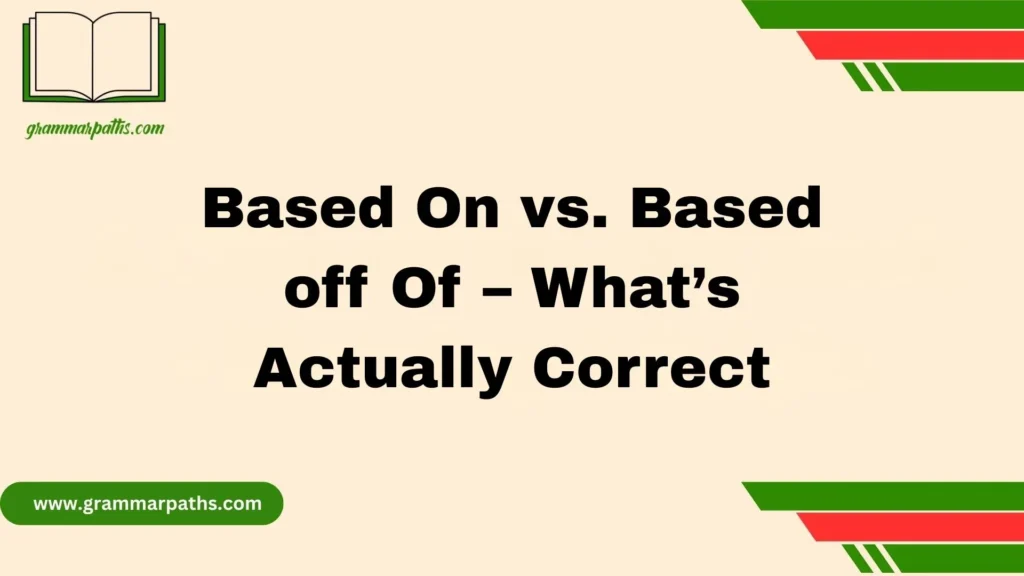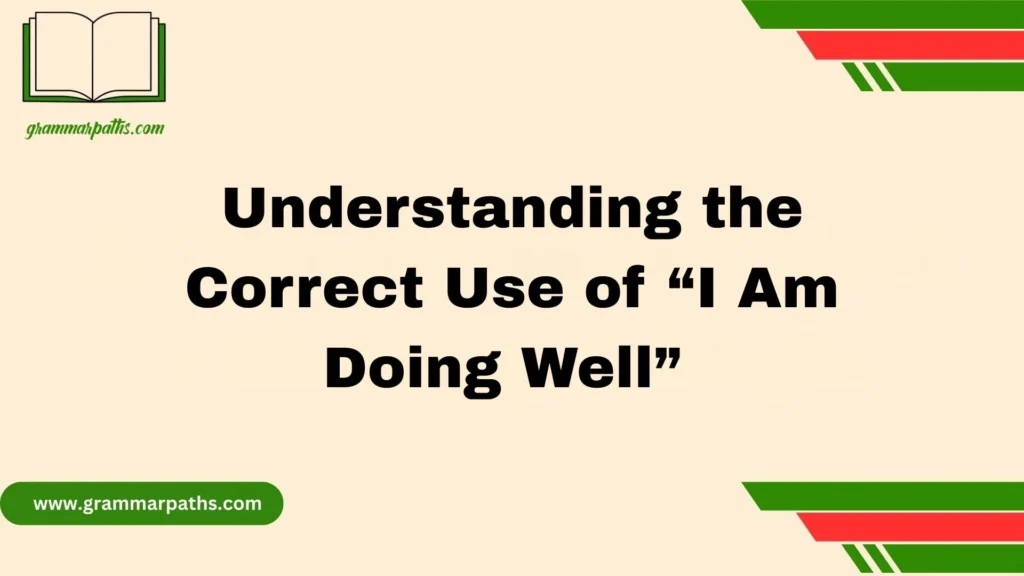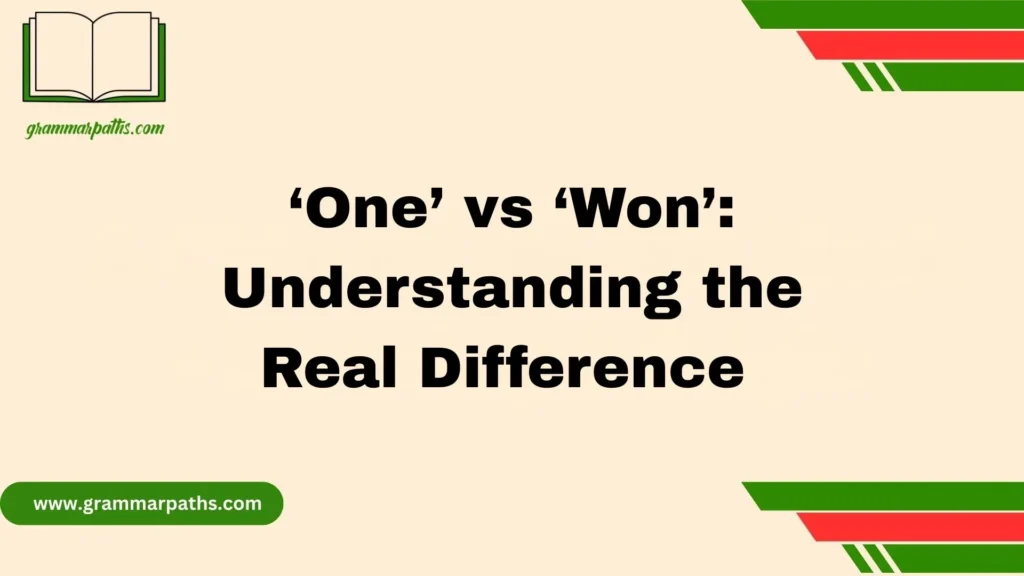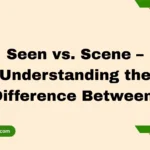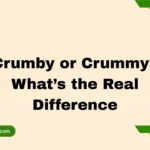The English language is full of words that sound the same but have completely different meanings, and “Seen vs. Scene” is a perfect example. These two words are homophones, meaning they’re pronounced alike but differ in spelling and usage. Understanding the difference between seen and scene is crucial for clear writing and communication.
The word “seen” is the past participle of see, used with helping verbs like have or had (for example, “I have seen that movie”). On the other hand, “scene” refers to a setting, location, or part of a play or movie, such as “The opening scene of the film was breathtaking.” Mixing them up can completely change the meaning of a sentence.
In this guide, we’ll explore the definition, examples, and proper usage of both words so you can easily tell them apart. Whether you’re a student, writer, or language enthusiast, mastering seen vs. scene grammar rules will help you write with confidence and precision. By the end, you’ll never confuse these two again — and your sentences will be grammatically flawless.
Understanding “Seen” – Definition, Meaning, and Grammar
What Does “Seen” Mean?
The word “seen” is the past participle of “see.” It’s a verb form used only with helping verbs such as have, has, or had to indicate that something has already been observed or witnessed.
Think of it this way: “seen” can’t stand on its own. It always needs a helper. Without that, it sounds incomplete or grammatically incorrect.
For example:
- I have seen that movie twice.
- I seen that movie twice.
Let’s break this down clearly in a table:
| Verb Form | Example | Usage Explanation |
| See | I see the sunrise every day. | Present tense (happening now) |
| Saw | I saw the sunrise yesterday. | Simple past (happened before) |
| Seen | I have seen many sunrises. | Past participle (used with have/has/had) |
When you use seen, it implies experience or prior observation—you witnessed or encountered something before now.
Examples of “Seen” in Sentences
Real-world usage helps the concept stick. Here are a few examples of seen in action:
- She has seen all the episodes of that show.
- Have you seen my keys anywhere?
- They had seen the warning signs but ignored them.
- I’ve seen better performances from this team.
- We haven’t seen the last of her—she’ll be back!
Each example uses seen alongside a helping verb (has, have, had). Notice how removing that helper instantly breaks the grammar.
Common Errors with “Seen”
This is where many English learners—and even native speakers—trip up. One of the most frequent grammar mistakes is saying “I seen” instead of “I saw.”
Here’s a quick guide to avoid that pitfall:
| Incorrect | Correct | Why |
| I seen it yesterday. | I saw it yesterday. | “Seen” needs a helper verb. |
| I have saw it before. | I have seen it before. | “Saw” doesn’t follow have/has/had. |
| I seen her at the store. | I saw her at the store. | “Seen” alone is never correct. |
This confusion often arises in casual speech, especially in certain dialects or informal conversations. However, in academic or professional writing, always use the standard form: have seen or saw—never I seen.
Understanding “Scene” – Definition, Meaning, and Usage
What Does “Scene” Mean?
The word “scene” is a noun. It refers to a place, setting, or moment—either in reality or imagination—where something happens.
The word often appears in the world of movies, theater, writing, or police reports, describing a specific location or part of an event.
Core meanings of “scene”:
- A section of a movie, play, or book.
- The final scene of the movie was unforgettable.
- The location where something happens.
- Police rushed to the scene of the accident.
- A display of strong emotion or commotion.
- Please don’t make a scene in front of everyone.
Let’s organize this for clarity:
| Meaning Type | Definition | Example |
| Artistic/Film | A segment of a play or movie. | The wedding scene was beautifully shot. |
| Physical Location | The place where an event occurs. | Reporters arrived quickly at the crime scene. |
| Emotional Outburst | A loud or embarrassing situation. | He made a scene at the restaurant. |
Examples of “Scene” in Sentences
Seeing scene in different contexts makes its meaning clear:
- The opening scene of the play set the mood perfectly.
- Tourists gathered at the scene to take pictures.
- Behind the scene, the staff worked tirelessly to make the event a success.
- Don’t create a scene over something so small.
These examples show how scene fits naturally as a noun describing places, moments, or emotional situations.
Common Phrases and Idioms Using “Scene”
The English language is full of idioms and expressions that use “scene.” Understanding these helps you sound more fluent and natural.
| Idiom / Phrase | Meaning | Example |
| Behind the scenes | Something done secretly or privately. | A lot of planning happens behind the scenes. |
| Set the scene | Describe the background or situation. | Let me set the scene before we begin. |
| Steal the scene | Attract more attention than others. | The youngest actor completely stole the scene. |
| Make a scene | Cause a public disturbance. | He made a scene when his meal was late. |
These idioms often appear in both everyday speech and professional writing. Knowing them adds richness to your language.
Seen vs. Scene – Key Differences Explained
Despite sounding identical, seen and scene couldn’t be more different in how they function.
Here’s the clear breakdown:
| Feature | Seen | Scene |
| Part of Speech | Verb (past participle) | Noun |
| Used With | Have / Has / Had | Independently |
| Meaning | To have observed something | A location or part of an event |
| Example | I have seen that actor before. | That was the funniest scene in the movie. |
| Common Error | ❌ I seen that. | ❌ The seen was amazing. |
To visualize it better:
- Seen = Action (something you did)
- Scene = Place or Moment (something you watch or read about)
Example Sentence:
I’ve seen that movie scene before.
In that single line, both words work correctly—seen shows the action of watching, while scene names the segment of the movie.
Tricks to Remember the Difference
Confusing seen and scene is easy, but remembering their difference is even easier once you use a few clever tricks.
1. Word Association
- Seen rhymes with been—both need have/has/had.
- Scene sounds like screen—think of a movie screen showing a scene.
2. Visual Mnemonic
Imagine this:
- Seen → someone looking at something (action).
- Scene → the picture or setting being looked at (place).
3. Letter Clue
- “Scene” has the letters “sce” — think scenery or script, both nouns.
- “Seen” has two “e’s” like “been,” which is always used with a helping verb.
4. Memory Sentence
“I’ve seen this movie scene before.”
Say it out loud a few times—it sticks fast because both words appear correctly in one memorable line.
Common Idioms and Expressions with “Seen”
While scene dominates idioms in English, seen appears in a few expressive phrases that highlight experience, endurance, or familiarity.
| Expression | Meaning | Example |
| I’ve seen better days | Things used to be better. | After losing his job, he said he’d seen better days. |
| Be seen with (someone) | Be noticed in public together. | She was seen with a famous actor at the event. |
| Seen it all | Not easily surprised anymore. | After 20 years in journalism, she’s seen it all. |
| Never seen the like | Express amazement or shock. | I’ve never seen the like of it before! |
These phrases emphasize experience—the very essence of what “seen” represents.
Why Knowing the Difference Between “Seen” and “Scene” Matters
Understanding this distinction does more than improve grammar—it enhances clarity, credibility, and confidence in your communication.
Here’s why it truly matters:
1. Professional and Academic Writing
Using seen and scene correctly prevents your writing from appearing careless. In professional or educational settings, one wrong word can alter meaning or reduce credibility.
Example:
- The seen of the accident was tragic.
- The scene of the accident was tragic.
2. Everyday Communication
Misusing homophones in texts or emails can cause confusion. Imagine writing, “Have you scene it?”—it might make readers pause and question your grammar.
3. Language Mastery
These small distinctions help develop deeper fluency and confidence. Understanding why seen and scene differ trains your brain to recognize patterns in other homophones too (like their/there/they’re or pair/pear).
4. Case Study: Clarity in Creative Writing
Consider a film review example:
“The director has seen growth in his storytelling, especially in the opening scene of the film.”
Here, both words coexist perfectly—the first conveys experience (verb), and the second describes a part of the movie (noun). Mixing them up would instantly ruin the sentence’s professionalism.
Quick Recap and Summary Chart
Here’s a clear one-glance summary to keep everything straight:
| Word | Part of Speech | Meaning | Example | Common Mistake |
| Seen | Verb (past participle) | To have observed or witnessed something | I have seen the sunrise. | “I seen the sunrise.” |
| Scene | Noun | A setting, place, or part of an event | The final scene was emotional. | “The seen was emotional.” |
Bonus Tip:
When proofreading, say your sentence aloud. If the word fits after “have,” “has,” or “had,” you need seen.
If it describes a location or event, you need scene.
Conclusion
In the battle of Seen vs. Scene, it’s all about understanding their roles in language. “Seen” belongs to the family of verbs—it’s the past participle of “see,” used with helping verbs like have or had. Meanwhile, “Scene” is a noun that paints a picture—a setting, a part of a play, or even a real-life event. Knowing the difference between seen and scene helps you avoid embarrassing grammar mistakes and makes your writing clearer and more professional.
FAQs
Q1: What part of speech is “seen”?
A: “Seen” is the past participle of the verb “see.” It always needs a helping verb like have, has, or had.
Q2: What does “scene” mean?
A: “Scene” is a noun that refers to a location, event, or part of a movie or play.
Q3: Can “seen” be used without a helping verb?
A: No. Saying “I seen it” is incorrect. The right form is “I have seen it.”
Q4: Are “seen” and “scene” pronounced the same?
A: Yes, they’re homophones—they sound identical but differ in meaning and spelling.
Q5: What’s a simple trick to remember the difference?
A: Think of “scene” as what you see in a movie or place—it describes the setting. “Seen” is what you’ve already seen with your eyes.

Mia Rose is the passionate writer and founder of GrammarPaths.com, a resource dedicated to helping learners master English grammar, idioms, and writing skills with ease. With a deep love for language and years of experience in teaching and content creation, Mia simplifies complex grammar rules into clear, practical guides that readers can instantly apply.
